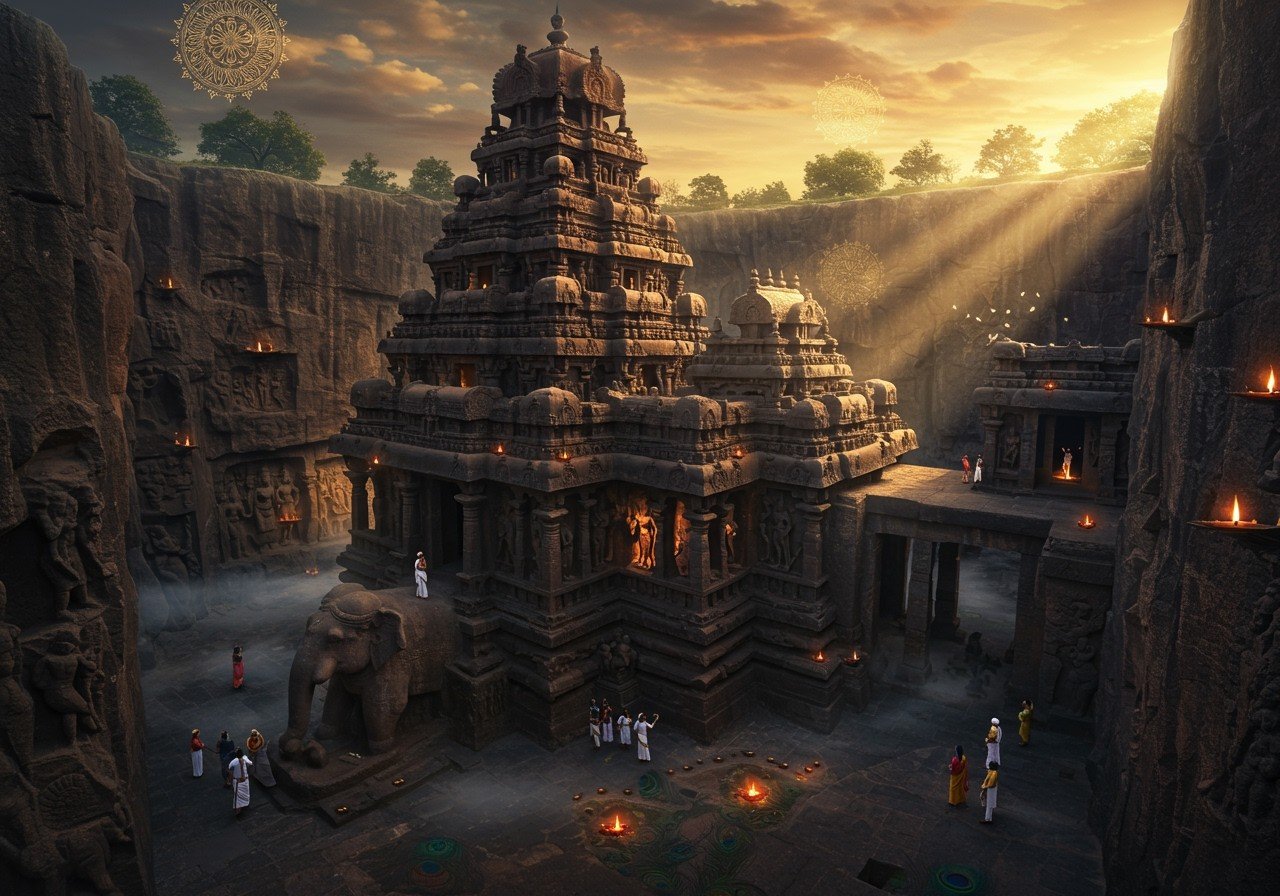
The Rashtrakuta Empire, which flourished between the 6th and 10th centuries, left an indelible mark on Indian art and architecture. This dynasty’s architectural marvels, characterized by intricate designs, innovative techniques, and magnificent temples, are a testament to their sophisticated craftsmanship and cultural richness. This blog delves into the splendor of Rashtrakuta architecture, exploring its origins, unique characteristics, and enduring legacy.
Origins and Distinctive Features of Rashtrakuta Architecture
Drawing inspiration from the Chalukyas, Rashtrakuta architecture developed a unique style that blended Dravidian and Nagara elements. The empire’s artisans skillfully employed both rock-cut excavation and structural construction techniques, resulting in diverse and awe-inspiring structures. Key features include:
- Intricate Carvings and Sculptures: Rashtrakuta temples are renowned for their elaborate carvings and sculptures, depicting deities, mythological scenes, and intricate patterns. These artistic details showcase the exceptional skill and artistry of the empire’s sculptors.
- Monolithic Structures: The Rashtrakutas mastered the art of monolithic construction, carving entire temples from single rocks. The Kailasa Temple at Ellora is a prime example of this remarkable technique, demonstrating the empire’s engineering prowess and artistic vision.
- Religious and Cultural Symbolism: Rashtrakuta architecture is deeply imbued with religious and cultural symbolism. The temples often feature depictions of Hindu deities, reflecting the empire’s devotion to religious expression and cultural preservation.
Ellora Caves: A Testament to Rashtrakuta Grandeur
The Ellora Caves, a UNESCO World Heritage Site, stand as a magnificent showcase of Rashtrakuta architectural achievements. The Kailasanatha Temple, commissioned by King Krishna I, is the largest rock-cut Hindu temple in Ellora, Maharashtra and epitomizes the empire’s mastery of rock-cut architecture. Key highlights include:
- Architectural Techniques in the Kailasa Temple: The Kailasa Temple’s intricate carvings, elaborate sculptures, and grand design demonstrate the sophisticated architectural techniques employed by the Rashtrakutas. Its two-storeyed structure, adorned with significant sculptural panels depicting the ten avatars of Vishnu, exemplifies the empire’s artistic and engineering prowess.
- Sculptures Depicting Hindu Deities: The Ellora Caves feature a wealth of sculptures portraying Hindu deities, offering insights into the religious beliefs and practices of the Rashtrakuta period. These sculptures, carved with remarkable detail and precision, represent a significant contribution to Indian religious art.
- Blend of Hindu, Buddhist, and Jain Traditions: The Ellora Caves complex houses a unique blend of Hindu, Buddhist, and Jain cave temples, reflecting the religious harmony and cultural exchange that characterized the Rashtrakuta Empire. This coexistence of diverse religious traditions within a single site underscores the empire’s tolerance and inclusivity.
Learn more about the Dharmaraya Swamy Temple: Popular Culture, Photos, Reviews & Experiences and History, Significance, and Karaga Festival.
The Temples of Pattadakal: A UNESCO World Heritage Site
Pattadakal, another UNESCO World Heritage Site, showcases the architectural contributions of the Rashtrakutas, particularly the Virupaksha and Mallikarjuna temples. These temples exemplify the fusion of Dravidian and Nagara styles, adorned with intricate carvings that narrate mythological stories.
- Virupaksha and Mallikarjuna Temples: The Virupaksha and Mallikarjuna temples at Pattadakal are prime examples of Rashtrakuta architecture, showcasing the empire’s mastery of temple design and construction. These temples feature elaborate carvings, grand structures, and intricate details that reflect the empire’s artistic and architectural prowess.
- Intricate Carvings Depicting Mythological Stories: The carvings on the temples at Pattadakal narrate mythological stories, providing valuable insights into the religious beliefs and cultural traditions of the Rashtrakuta period. These intricate carvings, executed with precision and artistry, represent a significant contribution to Indian narrative art.
- Cultural and Religious Importance in Rashtrakuta Society: The temples at Pattadakal played a vital role in the cultural and religious life of the Rashtrakuta Empire. They served as centers of worship, pilgrimage, and cultural exchange, reflecting the empire’s deep devotion to religious expression and cultural preservation.
Explore more about Ranganathaswamy Temple: A Complete Guide and A Spiritual Journey Guide. Also, discover Shree Vishnumurthy Temples in Karnataka.
The Enduring Legacy of Rashtrakuta Architecture
The influence of Rashtrakuta architecture extended far beyond the empire’s reign, impacting later South Indian dynasties such as the Cholas and Hoysalas. The tradition of rock-cut and structural temples continued to flourish, incorporating stylistic elements pioneered by the Rashtrakutas. Their innovations in temple construction techniques and the rich cultural symbolism embedded in their designs continue to inspire and resonate with us today.
The Vital Role of Royal Patronage
Royal patronage played a crucial role in the flourishing of Rashtrakuta architecture. Rulers like King Krishna I and Amoghavarsha I generously supported temple construction, fostering a close relationship between the court and religious institutions. Guilds of skilled artisans and craftsmen were commissioned for these grand projects, contributing their expertise to the creation of architectural masterpieces.
Poojn.in: Connecting You with India’s Rich Temple Heritage
At Poojn.in, we offer a wide selection of authentic puja items, including traditional brass bells, puja thalis, diya and lamp holders, and incense holders, designed to enhance your spiritual practices and connect you with India’s rich temple traditions. Explore our collection of Radha Krishna Bigraha, Maa Laxmi Lord Ganesha Murti, Laddu Gopal Murti and more. Also check out our detailed guides on Famous Lakshmi Narasimha Swamy Temples.
Conclusion: A Timeless Legacy of Architectural Brilliance
The Rashtrakuta Empire’s architectural legacy continues to inspire awe and admiration. Their unique blend of architectural styles, intricate carvings, and magnificent temples stand as a testament to their advanced skills, artistic vision, and profound cultural significance. By preserving and studying these architectural treasures, we ensure that the grandeur of the Rashtrakutas endures, inspiring future generations and enriching our understanding of India’s rich cultural heritage.


